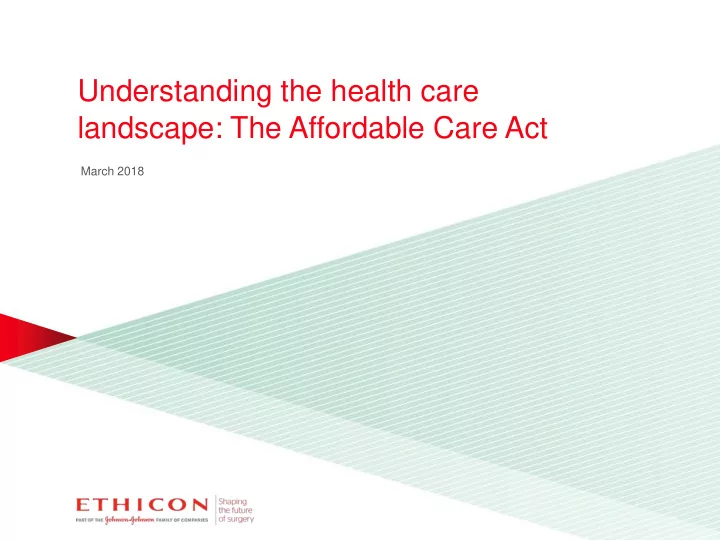

Understanding the health care landscape: The Affordable Care Act March 2018
Top 10 CEO Concerns and Triple Aim Concept 1. Financial Challenges 2. Healthcare Reform Implementation 3. Governmental Mandates Top 10 CEO Concerns 1 4. Patient Safety and Quality 5. Care for the Uninsured 6. Patient Satisfaction 7. Physician-Hospital Relations 8. Population Health Management 9. Technology 10. Personnel Shortages Healthy People/Healthy Better Care: Communities: Affordable Care: Advance the overall Support proven Reduce the cost of quality of health care by interventions and deliver quality health care focusing on patients higher-quality care Reference: 1. American College of Healthcare Executives – Survey: Healthcare Finance, Reform Top Issues Confronting Hospitals in 2014. http://www.ache.org/PUBS/research/ceoissues.cfm. Accessed March 8, 2018. (C) 2018 Ethicon, US LLC. 031558-180206
Impact of Affordable Care Act on Hospital Systems Regulatory Provider Opportunities Affordable Care Act Requirements in Changing Landscape • Reportable quality • Lower/eliminate • Centers for Medicare & metrics 1,3,4 readmissions Medicaid Services (CMS) readmission penalties 1 • Measured patient • Eliminate healthcare outcomes 3,4 acquired infections • Non-payment of Healthcare Acquired • Patient satisfaction • Increase patient Conditions (HACs) 2 reporting 3,4 satisfaction • Value-based purchasing 3 • Evidence-based medicine • Improve patient practices/protocols outcomes References: 1. Medicare Program; Hospital Inpatient Prospective Payment Systems for Acute Care Hospitals and the Long-Term Care Hospital Prospective Payment System and FY2012 Rates; Hospitals’ FTE Resident Caps for Graduate Medical Education Payment, Federal Register, Volume 76, Number 160, Thursday, August 18, 2011. Accessed March 19, 2015. 2. Medicare Program: Changes to the Hospital Inpatient Prospective Payment Systems and Fiscal Year 2009 Rates; Payments for Graduate Medical Education in Certain Emergency Situations; Changes to Disclosure of Physician Ownership in Hospitals and Physician Self-Referral Rules; Updates to the Long-Term Care Prospective Payment System; Updates to Prospective Payment System; Updates to Certain IPPS-Excluded Hospitals; and Collection of Information Regarding Financial Relationship Between Hospitals; Final Rule, Federal Register, Volume 73, Number 161, Tuesday, August, 19, 2008. Accessed March 19, 2015. 3. Medicare Program: Hospital Inpatient Value-Based Purchasing Program, Federal Register, Volume 76, Number 88, Friday, May 6, 2011. Accessed March 19, 2015. 4. Medicare Program; Medicare Shared Savings Program: Accountable Care Organizations, Federal Register, Volume 76, Number 212, Wednesday, November, 2, 2011. Accessed March 19, 2015. (C) 2018 Ethicon, US LLC. 031558-180206
Percentage of Medicare Reimbursement at Stake by Fiscal Year 2017 Readmission Reduction Healthcare Acquired Value-Based Condition Program 3 Purchasing 1 Program 2 Up Up 1 % 2 % to 3 % to • Clinical process • Acute myocardial infarction • Agency for Healthcare Research and Quality PSI-90 Composite • Patient experience • Heart failure • Catheter-associated urinary tract infections (patient satisfaction) • Pneumonia • Outcomes (SSI: colon • Central line-associated bloodstream infection • Chronic obstructive surgery & abdominal • Surgical site infections (colon surgery & hysterectomy) pulmonary disease abdominal hysterectomy) • Efficiency (medicare • Total hip arthroplasty • Methicillin-resistant Staphylococcus aureus spending per beneficiary) • Total knee arthroplasty • Clostridium difficile SSI=surgical site infection. References: 1. The Advisory Board Company, Healthcare Industry Committee. Hospital Value-Based Purchasing. C-Suite Cheat Sheet Series. August 2013. 2. The Advisory Board Company, Healthcare Industry Committee. Hospital Readmissions Reduction Program. C- Suite Cheat Sheet Series. August 2013. 3. The Advisory Board Company, Healthcare Industry Committee. Hospital-Acquired Condition Reduction Program. C-Suite Cheat Sheet Series. August 2013. (C) 2018 Ethicon, US LLC. 031558-180206
Your Hospital Data and Outcome Measures SSI: Colon Surgery & Abdominal Hysterectomy Rate of Unplanned Readmissions After Hip/Knee Surgery Survey of Patient Experience Link to website below http://www.medicare.gov/hospitalcompare/search.html (C) 2018 Ethicon, US LLC. 031558-180206
Factors That Impact Your Hospital • Changes in health care reimbursements • Evidence-based Uncontrollable Controllable device selection • Patient comorbidities • Transition of care • Type of procedure (discharge order set) • Patient’s age • Patient instructions and education • Discharge environment (C) 2018 Ethicon, US LLC. 031558-180206
Ethicon: Shaping the Future of Surgery We strive to live up to our legacy in 3 distinct ways 1 2 3 Help protect and Advance innovation Address pressing save more lives health care issues • Solutions that help create an • Help address risk factors • Technologies that advance optimal environment for associated with SSIs skin closure to meet hospital wound healing and patient needs • Proven to help reduce length of stay 1* * Applies to Dermabond Advanced Topical Skin Adhesive References: 1. Souza EC, Fitaroni RB, Januzelli DM, Macruz HMS, Camacho JCA, Souza MRC. Use of 2-octyl cyanoacrylate for skin closure of sternal incisions in cardiac surgery: observations of microbial barrier effects. Curr Med Res Opin. 2008;24(1):151-155. (C) 2018 Ethicon, US LLC. 031558-180206
Recommend
More recommend